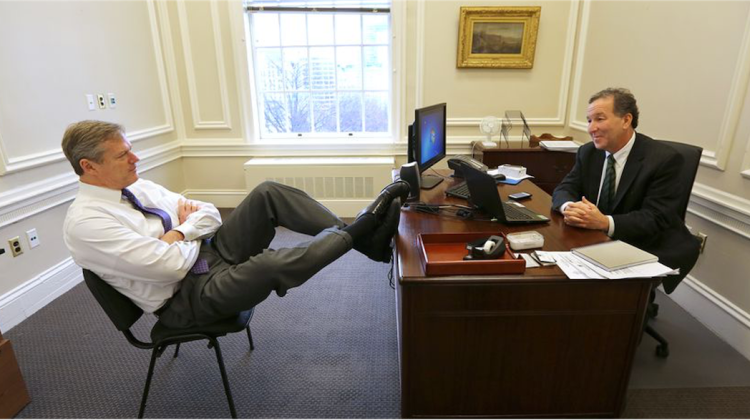Designing and Delivering More Effective Public Service

Governor Charlie Baker and then-chief of staff Steve Kadish settled in for their second day of work at the State House in January 2015.
Image credit: Pat Greenhouse, Boston Globe.
https://www.bostonglobe.com/2022/02/09/metro/governor-charlie-baker-release-first-book/
Currently two out of ten Americans trust the government’s ability to “do what is right, the majority of the time.”1 Yet many Americans express a desire to have the government play a central role in critical issues such as improving public health, alleviating poverty, and management of the economy.2 Furthermore, a majority of Americans continue to voice a belief that Americans can always innovate to solve challenges and achieve our desires. How does one reconcile the desire for the government to take on more responsibility and embody a problem solving ethos with a pessimism surrounding the government's ability to overcome politics and achieve results?
A new book, Results: Getting Beyond Politics to Get Important Work Done, builds on the experiences of Massachusetts Governor Charlie Baker and former Massachusetts Chief of Staff Steve Kadish to provide an actionable framework for public service to operate effectively and efficiently to rise to critical challenges and seize opportunities. Leveraging case studies from their tenure leading the government of Massachusetts, Baker and Kadish outline and demonstrate how to implement the Results Framework, a four pillar structure for designing and operationalizing comprehensive sustained change.
"The method we describe is not revolutionary, it’s evolutionary. It’s a step-by-step process that leads to sustainable results. This replicable framework places a special emphasis on how to implement. This method is for public sector leaders and managers, from public sector leaders, for the purpose of improving our public sector services. It was an approach born of necessity, because there were limited playbooks and less practical guidance for going from concept to delivery in the public sector. The basics of the Results Framework (People are Policy, Follow the Facts, Focus onHow, Push for Results) grew out of our experiences in government and was shaped by our experiences in the private sector,” said Kadish. “The strength of the Results Framework acknowledges that the basic rules of engagement differ between the public and private sector—and builds on a deep understanding of what makes the public sector different. We are not trying to bend government to the ways of the boardroom or C-suite. We can learn lessons from the private sector—and we do. However, real differences in the rules of the game make how to get things done in the public sector its own subject."
Kadish (MCP ‘82) has held numerous senior leadership roles in health care and higher education in both the public and the private sectors. During his tenure as Governor Baker’s first chief of staff, Kadish shaped and implemented policy and operational improvements in key state agencies and managed relations within the governor’s cabinet with the state legislature and with external stakeholders. He is wrapping up his fifth year as a senior research fellow at Harvard KennedySchool’s Taubman Center for State and Local Government.
Baker is Governor of Massachusetts. He has served as CEO of Harvard Pilgrim Health Care, a top-performing health-care insurance provider, and twice as Commonwealth of Massachusetts CabinetSecretary leading the Executive Office of Health and Human Services and theExecutive Office of Administration and Finance.
"Coming from a lifelong Republican (Governor Baker) and a lifelong Democrat (Steve Kadish) our approach is vehemently non-partisan," said Kadish. "The focus on people, facts, how, and results creates the platform for objective information, evaluation, action. In the end, we believe that our approach is not just about solving problems, but also about renewing faith in public services."
1. Public Trust in Government: 1958-2022, June6, 2022.https://www.pewresearch.org/politics/2022/06/06/public-trust-in-government-1958-2022/
2. “Americans’ Views of Government: Low Trust,but Some Positive Performance Ratings,” September 14, 2020. https://www.pewresearch.org/politics/2020/09/14/americans-views-of-government-low-trust-but-some-positive-performance-ratings/


